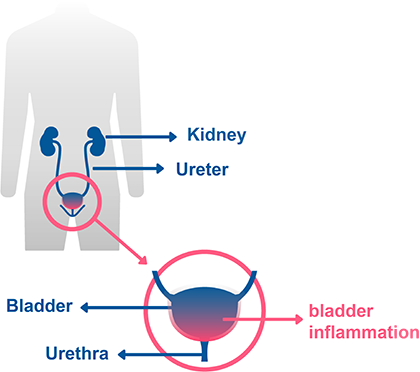


Cystitis is the inflammation of the bladder or urethra, usually caused by a bacterial infection.
Cystitis is a common type of urinary tract infection (UTI), characterized by a burning sensation when urinating, need to urinate frequently and pelvic pain.

Cystitis can be due to different causes, but the most common one is by bacterial germs. Most cases are caused by Escherichia Coli (E. Coli) bacteria.
Sometimes, cystitis is linked with poor hygiene habits. In women, it is a bad habit to wipe front back to front after going to the toilet because it spreads the bacteria from the rectal area to the urethra.
Cystitis is more common in women than in men because the female urethra is much shorter. This means that in women germs pass easily from the urethra to the bladder with a higher risk of developing urinary tract infection. In men, germs are usually washed out of the body when urinating.
Approximately 60% of women will experience cystitis during their lifetime.
In addition, cystitis is also common in pregnancy. Cystitis occurs in 1–2% of pregnant women.
Cystitis is frequent in diabetic patients (diabetes increases infections) or in people with structural or physiologic abnormalities of the urinary tract.
The most common symptoms of people with cystitis are:
It can be diagnosed by a urine culture. Because it usually takes a few days, it is common to use a urine dipstick or strip that offers a reliable result in a few minutes. This way it is possible to get a diagnosis and start the treatment with antibiotics as soon as possible.
Later, it is convenient to perform a urine culture to identify the responsible germ and to know if it is sensitive to the given antibiotic. In general practice, cystitis are so frequent that this step is only followed when there is recurrent cystitis to see if there is resistance to the antibiotic or any other possible causes.
In summary, your doctor may ask you the following tests:
The recommend treatment is antibiotic against the infection. After the antibiotic treatment, the symptoms will improve in 2-3 days. It is also recommended to increase daily water intake to help flush out any harmful bacteria.
The most used antibiotic to treat cystitis are:
If there are recurrent cystitis, it may be necessary to use antibiotics or urinary tract antiseptics for a long time (from 6 months to 2 years). They will be used at high doses in case of acute cystitis and at a lower dose in the rest.
Cystitis is an infectious disease and it is very important a properly clean of the genital area, especially in women. The perineum should be cleaned from “front to back” following defecation to minimize the risk of bowel organisms colonizing the urethra.
To reduce the frequency of cystitis the following measures may be a help:
Public toilets are not a risk for the transmission of cystitis, since it is necessary a close contact that is not common in these places.
Show more